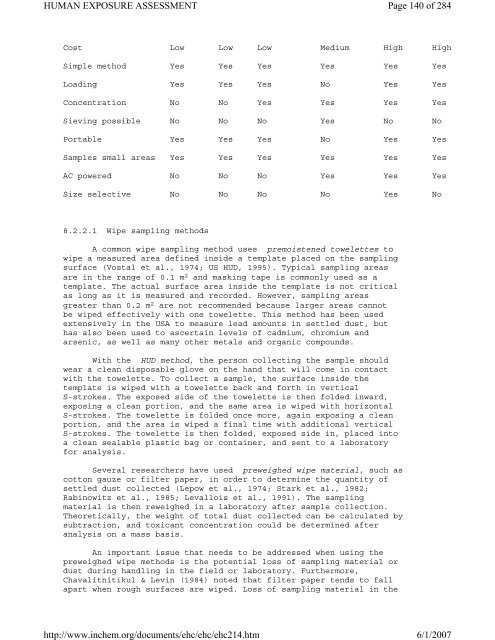Environmental Health Criteria 214
Environmental Health Criteria 214
Environmental Health Criteria 214
You also want an ePaper? Increase the reach of your titles
YUMPU automatically turns print PDFs into web optimized ePapers that Google loves.
HUMAN EXPOSURE ASSESSMENT<br />
Cost Low Low Low Medium High High<br />
Simple method Yes Yes Yes Yes Yes Yes<br />
Loading Yes Yes Yes No Yes Yes<br />
Concentration No No Yes Yes Yes Yes<br />
Sieving possible No No No Yes No No<br />
Portable Yes Yes Yes No Yes Yes<br />
Samples small areas Yes Yes Yes Yes Yes Yes<br />
AC powered No No No Yes Yes Yes<br />
Size selective No No No No Yes No<br />
8.2.2.1 Wipe sampling methods<br />
A common wipe sampling method uses premoistened towelettes to<br />
wipe a measured area defined inside a template placed on the sampling<br />
surface (Vostal et al., 1974; US HUD, 1995). Typical sampling areas<br />
are in the range of 0.1 m 2 and masking tape is commonly used as a<br />
template. The actual surface area inside the template is not critical<br />
as long as it is measured and recorded. However, sampling areas<br />
greater than 0.2 m 2 are not recommended because larger areas cannot<br />
be wiped effectively with one towelette. This method has been used<br />
extensively in the USA to measure lead amounts in settled dust, but<br />
has also been used to ascertain levels of cadmium, chromium and<br />
arsenic, as well as many other metals and organic compounds.<br />
With the HUD method, the person collecting the sample should<br />
wear a clean disposable glove on the hand that will come in contact<br />
with the towelette. To collect a sample, the surface inside the<br />
template is wiped with a towelette back and forth in vertical<br />
S-strokes. The exposed side of the towelette is then folded inward,<br />
exposing a clean portion, and the same area is wiped with horizontal<br />
S-strokes. The towelette is folded once more, again exposing a clean<br />
portion, and the area is wiped a final time with additional vertical<br />
S-strokes. The towelette is then folded, exposed side in, placed into<br />
a clean sealable plastic bag or container, and sent to a laboratory<br />
for analysis.<br />
Several researchers have used preweighed wipe material, such as<br />
cotton gauze or filter paper, in order to determine the quantity of<br />
settled dust collected (Lepow et al., 1974; Stark et al., 1982;<br />
Rabinowitz et al., 1985; Levallois et al., 1991). The sampling<br />
material is then reweighed in a laboratory after sample collection.<br />
Theoretically, the weight of total dust collected can be calculated by<br />
subtraction, and toxicant concentration could be determined after<br />
analysis on a mass basis.<br />
An important issue that needs to be addressed when using the<br />
preweighed wipe methods is the potential loss of sampling material or<br />
dust during handling in the field or laboratory. Furthermore,<br />
Chavalitnitikul & Levin (1984) noted that filter paper tends to fall<br />
apart when rough surfaces are wiped. Loss of sampling material in the<br />
http://www.inchem.org/documents/ehc/ehc/ehc<strong>214</strong>.htm<br />
Page 140 of 284<br />
6/1/2007

















